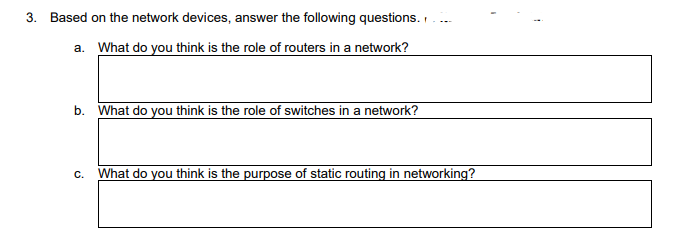3. Based on the network devices, answer the following questions..... a. What do you think is the role of routers in a network? b. What do you think is the role of switches in a network? c. What do you think is the purpose of static routing in networking?
3. Based on the network devices, answer the following questions..... a. What do you think is the role of routers in a network? b. What do you think is the role of switches in a network? c. What do you think is the purpose of static routing in networking?
Computer Networking: A Top-Down Approach (7th Edition)
7th Edition
ISBN:9780133594140
Author:James Kurose, Keith Ross
Publisher:James Kurose, Keith Ross
Chapter1: Computer Networks And The Internet
Section: Chapter Questions
Problem R1RQ: What is the difference between a host and an end system? List several different types of end...
Related questions
Question

Transcribed Image Text:3. Based on the network devices, answer the following questions.
a. What do you think is the role of routers in a network?
b. What do you think is the role of switches in a network?
C. What do you think is the purpose of static routing in networking?
![Laboratory Exercise
Static Routing
Objectives:
At the end of the exercise, the students should be able to:
• Assign IP addresses to PCs and routers; and
Check the connectivity of all interfaces using the PING command.
Principle:
Routing is the basic element of data communication networks in
which it is the process of selecting paths on a network along which
packets are sent from a source to a destination. Routes are the path
information used to guide packet forwarding. Network devices
need to forward IP packets from different subnets to their
destination IP subnets.
Static routes are manually configured by network administrators.
This can be an effective method for networks with small and simple
structures and reduce the effect of bandwidth and CPU resource
consumption that occurs when other protocols are implemented.
Example: [Huawei] ip route-static 30.1.1.0
Procedure:
PC2 Ethernet 0/0/1
GE 0/0/3
LSW1
PC1
Ethernet 0/0/1 GE 0/0/2
Device
AR1
AR2
PC1
PC2
PC3
PC4
GE 0/0/1
GE 0/0/1
Interface
GE 0/0/0
GE 0/0/1
GE 0/0/0
GE 0/0/1
GE 0/0/0
GE 0/0/0
GE 0/0/0
GE 0/0/0
30.1.1.0/24 R
Protocol Destination/Mask
Static
30.1.1.0/24
255.255.255.0 GEO/0/1
Ethernet 0/0/1 PC4
GE 0/0/3
GE 0/0/2 Ethernet 0/0/1
LSW2
AR1
AR2
RGE O/O/0
GE 0/0/0 R
Network Information List
IP Address
200.200.200.10
200.1.2.10
200.200.200.20
200.1.3.20
200.1.2.11
200.1.2.12
200.1.3.21
200.1.3.22
GE 0/0/1
GE 0/0/1
Subnet Mask
255.255.255.0
255.255.255.0
255.255.255.0
255.255.255.0
255.255.255.0
255.255.255.0
255.255.255.0
255.255.255.0
R
GEO/0/1
Outbound
Interface
GEO/0/1
PC3
Default Gateway
N/A
N/A
N/A
N/A
200.1.2.10
200.1.2.10
200.1.3.20
200.1.3.20](/v2/_next/image?url=https%3A%2F%2Fcontent.bartleby.com%2Fqna-images%2Fquestion%2F9bcb74ac-a2db-4993-bb71-430425c37a53%2F114cfe6e-9853-470d-9641-2f04dbd59266%2Frcchkvr_processed.png&w=3840&q=75)
Transcribed Image Text:Laboratory Exercise
Static Routing
Objectives:
At the end of the exercise, the students should be able to:
• Assign IP addresses to PCs and routers; and
Check the connectivity of all interfaces using the PING command.
Principle:
Routing is the basic element of data communication networks in
which it is the process of selecting paths on a network along which
packets are sent from a source to a destination. Routes are the path
information used to guide packet forwarding. Network devices
need to forward IP packets from different subnets to their
destination IP subnets.
Static routes are manually configured by network administrators.
This can be an effective method for networks with small and simple
structures and reduce the effect of bandwidth and CPU resource
consumption that occurs when other protocols are implemented.
Example: [Huawei] ip route-static 30.1.1.0
Procedure:
PC2 Ethernet 0/0/1
GE 0/0/3
LSW1
PC1
Ethernet 0/0/1 GE 0/0/2
Device
AR1
AR2
PC1
PC2
PC3
PC4
GE 0/0/1
GE 0/0/1
Interface
GE 0/0/0
GE 0/0/1
GE 0/0/0
GE 0/0/1
GE 0/0/0
GE 0/0/0
GE 0/0/0
GE 0/0/0
30.1.1.0/24 R
Protocol Destination/Mask
Static
30.1.1.0/24
255.255.255.0 GEO/0/1
Ethernet 0/0/1 PC4
GE 0/0/3
GE 0/0/2 Ethernet 0/0/1
LSW2
AR1
AR2
RGE O/O/0
GE 0/0/0 R
Network Information List
IP Address
200.200.200.10
200.1.2.10
200.200.200.20
200.1.3.20
200.1.2.11
200.1.2.12
200.1.3.21
200.1.3.22
GE 0/0/1
GE 0/0/1
Subnet Mask
255.255.255.0
255.255.255.0
255.255.255.0
255.255.255.0
255.255.255.0
255.255.255.0
255.255.255.0
255.255.255.0
R
GEO/0/1
Outbound
Interface
GEO/0/1
PC3
Default Gateway
N/A
N/A
N/A
N/A
200.1.2.10
200.1.2.10
200.1.3.20
200.1.3.20
Expert Solution
This question has been solved!
Explore an expertly crafted, step-by-step solution for a thorough understanding of key concepts.
Step by step
Solved in 2 steps

Recommended textbooks for you

Computer Networking: A Top-Down Approach (7th Edi…
Computer Engineering
ISBN:
9780133594140
Author:
James Kurose, Keith Ross
Publisher:
PEARSON

Computer Organization and Design MIPS Edition, Fi…
Computer Engineering
ISBN:
9780124077263
Author:
David A. Patterson, John L. Hennessy
Publisher:
Elsevier Science

Network+ Guide to Networks (MindTap Course List)
Computer Engineering
ISBN:
9781337569330
Author:
Jill West, Tamara Dean, Jean Andrews
Publisher:
Cengage Learning

Computer Networking: A Top-Down Approach (7th Edi…
Computer Engineering
ISBN:
9780133594140
Author:
James Kurose, Keith Ross
Publisher:
PEARSON

Computer Organization and Design MIPS Edition, Fi…
Computer Engineering
ISBN:
9780124077263
Author:
David A. Patterson, John L. Hennessy
Publisher:
Elsevier Science

Network+ Guide to Networks (MindTap Course List)
Computer Engineering
ISBN:
9781337569330
Author:
Jill West, Tamara Dean, Jean Andrews
Publisher:
Cengage Learning

Concepts of Database Management
Computer Engineering
ISBN:
9781337093422
Author:
Joy L. Starks, Philip J. Pratt, Mary Z. Last
Publisher:
Cengage Learning

Prelude to Programming
Computer Engineering
ISBN:
9780133750423
Author:
VENIT, Stewart
Publisher:
Pearson Education

Sc Business Data Communications and Networking, T…
Computer Engineering
ISBN:
9781119368830
Author:
FITZGERALD
Publisher:
WILEY